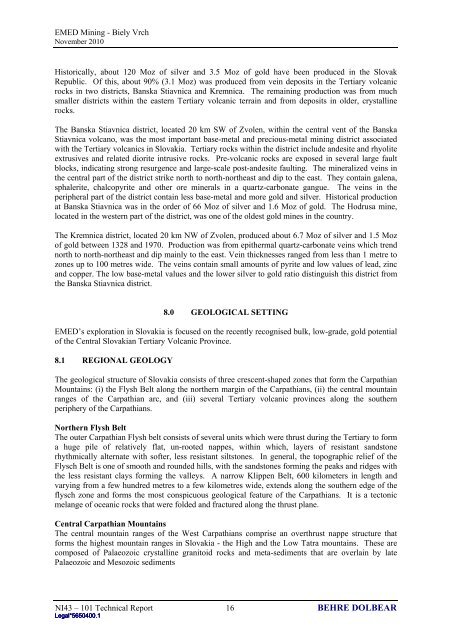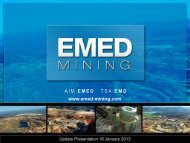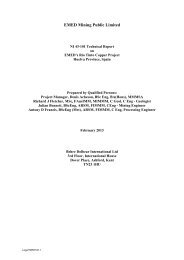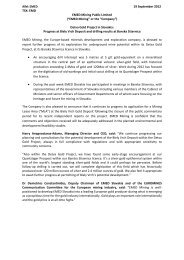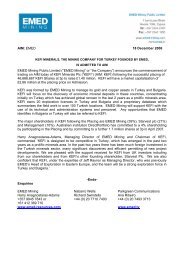Ammended NI 43-101 Technical Report on the Biely ... - EMED Mining
Ammended NI 43-101 Technical Report on the Biely ... - EMED Mining
Ammended NI 43-101 Technical Report on the Biely ... - EMED Mining
You also want an ePaper? Increase the reach of your titles
YUMPU automatically turns print PDFs into web optimized ePapers that Google loves.
<strong>EMED</strong> <strong>Mining</strong> - <strong>Biely</strong> VrchNovember 2010Historically, about 120 Moz of silver and 3.5 Moz of gold have been produced in <strong>the</strong> SlovakRepublic. Of this, about 90% (3.1 Moz) was produced from vein deposits in <strong>the</strong> Tertiary volcanicrocks in two districts, Banska Stiavnica and Kremnica. The remaining producti<strong>on</strong> was from muchsmaller districts within <strong>the</strong> eastern Tertiary volcanic terrain and from deposits in older, crystallinerocks.The Banska Stiavnica district, located 20 km SW of Zvolen, within <strong>the</strong> central vent of <strong>the</strong> BanskaStiavnica volcano, was <strong>the</strong> most important base-metal and precious-metal mining district associatedwith <strong>the</strong> Tertiary volcanics in Slovakia. Tertiary rocks within <strong>the</strong> district include andesite and rhyoliteextrusives and related diorite intrusive rocks. Pre-volcanic rocks are exposed in several large faultblocks, indicating str<strong>on</strong>g resurgence and large-scale post-andesite faulting. The mineralized veins in<strong>the</strong> central part of <strong>the</strong> district strike north to north-nor<strong>the</strong>ast and dip to <strong>the</strong> east. They c<strong>on</strong>tain galena,sphalerite, chalcopyrite and o<strong>the</strong>r ore minerals in a quartz-carb<strong>on</strong>ate gangue. The veins in <strong>the</strong>peripheral part of <strong>the</strong> district c<strong>on</strong>tain less base-metal and more gold and silver. Historical producti<strong>on</strong>at Banska Stiavnica was in <strong>the</strong> order of 66 Moz of silver and 1.6 Moz of gold. The Hodrusa mine,located in <strong>the</strong> western part of <strong>the</strong> district, was <strong>on</strong>e of <strong>the</strong> oldest gold mines in <strong>the</strong> country.The Kremnica district, located 20 km NW of Zvolen, produced about 6.7 Moz of silver and 1.5 Mozof gold between 1328 and 1970. Producti<strong>on</strong> was from epi<strong>the</strong>rmal quartz-carb<strong>on</strong>ate veins which trendnorth to north-nor<strong>the</strong>ast and dip mainly to <strong>the</strong> east. Vein thicknesses ranged from less than 1 metre toz<strong>on</strong>es up to 100 metres wide. The veins c<strong>on</strong>tain small amounts of pyrite and low values of lead, zincand copper. The low base-metal values and <strong>the</strong> lower silver to gold ratio distinguish this district from<strong>the</strong> Banska Stiavnica district.8.0 GEOLOGICAL SETTING<strong>EMED</strong>’s explorati<strong>on</strong> in Slovakia is focused <strong>on</strong> <strong>the</strong> recently recognised bulk, low-grade, gold potentialof <strong>the</strong> Central Slovakian Tertiary Volcanic Province.8.1 REGIONAL GEOLOGYThe geological structure of Slovakia c<strong>on</strong>sists of three crescent-shaped z<strong>on</strong>es that form <strong>the</strong> CarpathianMountains: (i) <strong>the</strong> Flysh Belt al<strong>on</strong>g <strong>the</strong> nor<strong>the</strong>rn margin of <strong>the</strong> Carpathians, (ii) <strong>the</strong> central mountainranges of <strong>the</strong> Carpathian arc, and (iii) several Tertiary volcanic provinces al<strong>on</strong>g <strong>the</strong> sou<strong>the</strong>rnperiphery of <strong>the</strong> Carpathians.Nor<strong>the</strong>rn Flysh BeltThe outer Carpathian Flysh belt c<strong>on</strong>sists of several units which were thrust during <strong>the</strong> Tertiary to forma huge pile of relatively flat, un-rooted nappes, within which, layers of resistant sandst<strong>on</strong>erhythmically alternate with softer, less resistant siltst<strong>on</strong>es. In general, <strong>the</strong> topographic relief of <strong>the</strong>Flysch Belt is <strong>on</strong>e of smooth and rounded hills, with <strong>the</strong> sandst<strong>on</strong>es forming <strong>the</strong> peaks and ridges with<strong>the</strong> less resistant clays forming <strong>the</strong> valleys. A narrow Klippen Belt, 600 kilometers in length andvarying from a few hundred metres to a few kilometres wide, extends al<strong>on</strong>g <strong>the</strong> sou<strong>the</strong>rn edge of <strong>the</strong>flysch z<strong>on</strong>e and forms <strong>the</strong> most c<strong>on</strong>spicuous geological feature of <strong>the</strong> Carpathians. It is a tect<strong>on</strong>icmelange of oceanic rocks that were folded and fractured al<strong>on</strong>g <strong>the</strong> thrust plane.Central Carpathian MountainsThe central mountain ranges of <strong>the</strong> West Carpathians comprise an overthrust nappe structure thatforms <strong>the</strong> highest mountain ranges in Slovakia - <strong>the</strong> High and <strong>the</strong> Low Tatra mountains. These arecomposed of Palaeozoic crystalline granitoid rocks and meta-sediments that are overlain by latePalaeozoic and Mesozoic sediments<str<strong>on</strong>g>NI</str<strong>on</strong>g><str<strong>on</strong>g>43</str<strong>on</strong>g> – <str<strong>on</strong>g>101</str<strong>on</strong>g> <str<strong>on</strong>g>Technical</str<strong>on</strong>g> <str<strong>on</strong>g>Report</str<strong>on</strong>g> 16 BEHRE DOLBEARLegal*5650400.1


